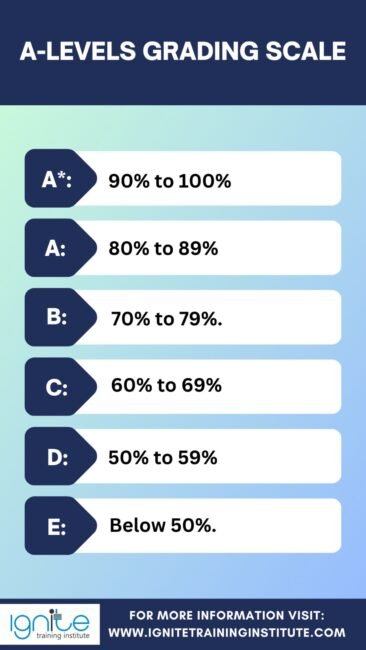Embarking on the A-Level journey involves navigating the intricacies of a grading system that can significantly shape one’s educational trajectory. Understanding how A-Level grades are determined is essential for students aiming to excel in these advanced-level examinations. In this blog, we delve into the A-Level grading system, unraveling the complexities to shed light on how student performance is assessed and final grades are awarded.
Additionally, for those seeking guidance and support on their A-Level path, Ignite Training Institute proudly stands as a beacon of academic assistance in Dubai. Our A-Level expert tutors, well-versed in the nuances of the curriculum, are dedicated to providing personalized and comprehensive tutoring services, ensuring students not only understand but excel in their A-Level subjects.
Join us on this exploration of the A-Level grading system and discover how Ignite Training Institute can elevate your academic journey in Dubai.
Table of Contents
- What Is A-Levels Grading System?
- What Are A-Level Grade Boundaries & Its Significance
- What Do A-Level Grade Percentage Equivalents Do?
- How Are AS & A2 Grades Combined?
- Importance Of A-Levels In College Applications
- How Universities Use A-Level Grades In Admissions Decisions?
- 5 Study Tips For Achieving Top A-Level Grades
- Ignite Training Institute: Succeed With Best A-Level Tutors In Dubai
- FAQs
- Conclusion
What Is A-Levels Grading System?
The A-level grading system is a fundamental aspect of the British education system, providing a standardized method for assessing students’ academic achievements in their final years of secondary education. A-Levels, short for Advanced Level qualifications, are widely recognized and accepted by universities both in the United Kingdom and around the world. The grading system is pivotal in determining a student’s eligibility for higher education and can significantly impact their future academic and professional pursuits.
A-Levels are typically pursued by students aged 16 to 18, after completing their General Certificate of Secondary Education (GCSE) examinations. Students usually choose three to four subjects to specialize in during their A-Level studies, and the grades obtained in these subjects contribute to the final A-Level qualification.
The A-Levels grading system employs a letter scale, ranging from A* (the highest) to E (the lowest). Each grade represents a specific level of achievement in a subject. Examination boards determine the grading criteria, and they assess students based on their performance in written exams, coursework, and practical assessments, depending on the nature of the subject.
Related: Top 10 A-Level Schools In Dubai: Recent Reviews & Insights
What Are A-Level Grade Boundaries & Its Significance

A-Level grade boundaries are predefined marks that establish the thresholds between different grades in a specific subject. These boundaries are set by examination boards and represent the minimum score a student needs to attain to achieve a particular grade. The grades are typically categorized on a letter scale from A* (A-Star) as the highest to E as the lowest.
A-Levels Grading Scale:
A (A-Star):* Reserved for exceptional performance, indicating a profound understanding and mastery of the subject matter.
A: Awarded for excellent performance, showcasing a thorough comprehension of the material.
B: Given for good performance, reflecting a solid understanding of the subject.
C: Granted for satisfactory performance, meeting the basic requirements.
D: Indicative of limited achievement, falling below the expected standard.
E: Represents minimal achievement, often not meeting the minimum requirements for progression.
Significance Of A-Level Grade Boundaries:
- Fair & Consistent Evaluation: Grade boundaries play a crucial role in ensuring fair and consistent evaluation of student performance. They provide a standardized method for comparing and categorizing the achievements of diverse cohorts of students.
- Guiding University Admissions: Higher education institutions heavily rely on A-Level grades during the admissions process. Grade boundaries become instrumental in assessing the academic qualifications of prospective students, helping universities make informed decisions about admissions.
- Yearly Variations: Grade boundaries can vary from year to year based on factors such as the difficulty of the examination papers and the overall performance of students. This flexibility allows for adjustments to maintain the standard of difficulty and uphold the credibility of the qualifications.
Related: Top 10 A-Level Schools In Dubai: Recent Reviews & Insights
What Do A-Level Grade Percentage Equivalents Do?
One of the crucial aspects of the A-Level grading system lies in its representation of academic achievements through percentage ranges. These delineate the thresholds that distinguish one grade from another, providing both clarity and standardization in the assessment process.
Translating Grades into Percentages:
- A (A-Star):* Reserved for exceptional performance, the percentage range for an A* typically starts at around 90% and extends to the highest achievable score. This grade represents an extraordinary level of mastery and understanding of the subject matter.
- A: Reflecting excellent performance, the percentage range for an A commonly falls within the bracket of 80% to 89%. This grade signifies a comprehensive grasp of the material and a high level of proficiency.
- B: Designating good performance, the percentage range for a B typically ranges from 70% to 79%. This grade acknowledges a solid understanding of the subject and a commendable level of achievement.
- C: Indicating satisfactory performance, the percentage range for a C generally spans from 60% to 69%. This grade signifies meeting the basic requirements with a satisfactory level of competency.
- D: Representing limited achievement, the percentage range for a D typically falls between 50% and 59%. This grade indicates a performance below the expected standard but still meets minimum requirements.
- E: Reflecting minimal achievement, the percentage range for an E is usually below 50%. This grade suggests a performance that may not meet the minimum requirements for progression.
The use of percentage ranges ensures precision in grading, offering a nuanced evaluation of a student’s performance. It also allows for flexibility, accommodating variations in the difficulty of different examination papers and maintaining consistency across various subjects.
Related: Top 10 A-Level Schools In Dubai: Recent Reviews & Insights
How Are AS & A2 Grades Combined?
In many educational systems, particularly in the United Kingdom, Advanced Subsidiary (AS) and Advanced Level (A2) qualifications are commonly pursued by students during their post-16 education. These qualifications are usually associated with the General Certificate of Education (GCE) system and are taken in specific subjects.
AS and A2 levels represent different stages within the A-level qualification, with AS typically being the first half of the course and A2 being the second half. The combination of AS and A2 grades plays a crucial role in determining a student’s final A-level result.
- Grading System: Both AS and A2 units are graded on a scale, typically from A to E, with A being the highest grade and E the lowest. The grades achieved in both AS and A2 units are important for the final A-level result.
- Weighted Averages: The AS grades contribute to the overall A-level grade, but they are not simply added to the A2 grades. Instead, a weighted average is calculated. The weightings may vary, but it is common for AS units to contribute 50% to the overall A-level grade, with the A2 units contributing the remaining 50%.
- Final A-level Grade: The combined result of AS and A2 units determines the final A-level grade awarded to the student. Some subjects may have additional requirements, such as completing coursework or practical assessments, which also factor into the overall grade.
- UCAS Points: In the UK, universities often use the UCAS (Universities and Colleges Admissions Service) point system to assess applicants. AS and A2 grades are converted into UCAS points, which are then used for university admissions.
Related: Top 10 A-Level Schools In Dubai: Recent Reviews & Insights
Importance Of A-Levels In College Applications
A-Levels, the pinnacle of the British education system, hold immense significance in the realm of college applications. As students embark on the journey towards higher education, the grades achieved in A-Levels become a pivotal factor influencing college admissions. Here’s a glimpse into why A-Levels carry substantial weight in the college application process.
1. Academic Rigor & Depth
A-Levels are renowned for their academic rigor, providing students with an in-depth understanding of their chosen subjects. The advanced nature of A-Level coursework showcases a student’s ability to engage with challenging material, setting them apart academically.
2. Standardized Assessment
A-Levels offer a standardized and widely recognized assessment system, providing colleges with a consistent benchmark to evaluate the academic capabilities of applicants. This allows for a fair comparison of students from different educational backgrounds.
3. University Entrance Requirements
Many universities set specific A-Level grade requirements for admission into their programs. Achieving the necessary grades not only demonstrates a student’s academic competence but also ensures they meet the prerequisites for their desired courses.
4. Academic Specialization
A-Levels allow students to specialize in subjects of their choice. This specialization aligns with college applications, allowing students to highlight their passion, proficiency, and commitment to specific academic disciplines.
5. Global Recognition
A-Levels enjoy international recognition, making them a valuable qualification for students applying to colleges not only in the United Kingdom but also around the world. The global credibility of A-Levels enhances the competitiveness of college applications on an international scale.
6. Holistic Evaluation
Colleges often look beyond standardized test scores and consider the holistic academic profile of applicants. A-Levels contribute significantly to this overall evaluation, offering insights into a student’s analytical skills, critical thinking abilities, and subject mastery.
Related: Top 10 A-Level Schools In Dubai: Recent Reviews & Insights
How Universities Use A-Level Grades In Admissions Decisions?
Universities in the United Kingdom heavily rely on A-level grades when making admissions decisions, considering them a pivotal factor in assessing a student’s academic readiness for higher education. A-Level grades are viewed as a reliable indicator of a student’s subject-specific knowledge, analytical skills, and overall academic ability. Admissions teams carefully review these grades to determine whether an applicant meets the academic requirements for the chosen course.
The specific A-level grade requirements vary between universities and courses, with more competitive programs often demanding higher grades. Some universities may specify minimum entry requirements, while others adopt a holistic approach, considering not only the grades but also personal statements, letters of recommendation, and other factors. A-Levels provide universities with a standardized measure, allowing them to fairly evaluate students from different educational backgrounds.
In addition to meeting entry requirements, strong A-level grades can enhance an applicant’s chances of securing a place in a competitive program or gaining admission to a prestigious institution. Universities recognize the rigorous nature of A-Level examinations and value the depth of understanding they represent.
Related: Top 10 A-Level Schools In Dubai: Recent Reviews & Insights
5 Study Tips For Achieving Top A-Level Grades
Achieving top A-Level grades requires strategic study habits and dedication. Here are five effective study tips to help you excel:
- Organized Planning: Develop a detailed study schedule that allocates specific time for each subject. Prioritize challenging topics and spread out your study sessions to avoid last-minute cramming. A well-organized plan ensures comprehensive coverage of the syllabus.
- Active Engagement: Actively engage with your study material by taking thorough notes, creating flashcards, and practicing with past exam papers. Interactive learning reinforces understanding and helps commit information to memory, fostering a deeper grasp of the subject matter.
- Regular Review: Implement a regular review system to reinforce your learning. Periodically revisit previously covered material to solidify your understanding and identify any areas that may need further clarification. This ongoing review prevents forgetting and enhances long-term retention.
- Effective Revision Techniques: Tailor your revision techniques to suit your learning style. Experiment with methods such as mind mapping, summarization, and teaching concepts to others. Find what works best for you, and incorporate diverse revision strategies to keep your study sessions dynamic and engaging.
- Balanced Lifestyle: Maintain a balanced lifestyle that includes adequate sleep, healthy meals, and breaks. Physical and mental well-being significantly impact cognitive function. Striking a balance between study and self-care optimizes your ability to absorb information and perform best during exams.
Ignite Training Institute: Succeed With Best A-Level Tutors In Dubai
Ignite Training Institute stands as a beacon of academic success, offering students the opportunity to thrive under the guidance of the best A-Level tutors in Dubai. Committed to excellence, our institute is dedicated to providing top-tier education, personalized attention, and a nurturing environment that fosters intellectual growth. With a team of highly qualified and experienced tutors, we empower students to conquer the challenges of A-Level courses, ensuring comprehensive understanding and mastery of subjects.
At Ignite, we believe in not just imparting knowledge but also instilling confidence, critical thinking skills, and a passion for learning, setting our students on the path to academic success and a promising future.
FAQs
1. What Are The Grades For A Levels?
A-Levels are graded from A* (A-Star) as the highest to E as the lowest, with each grade representing a specific level of academic achievement.
2. What Is The Grading Scale For A-Level?
The A-Level grading scale ranges from A* (A-Star) as the highest grade to E as the lowest, reflecting varying levels of academic achievement.
3. What A-Level Grade Is 70%?
In the A-Level grading system, a score of around 70% typically corresponds to a grade B, indicating good performance and a solid understanding of the subject.
4. What Are The Grades For O Levels?
O Levels are typically graded from A (the highest) to G (the lowest), with each grade representing a different level of academic achievement.
Conclusion

As we conclude our exploration into the A-Level grading system, it becomes evident that these assessments are more than just numbers; they are a reflection of a student’s dedication, understanding, and perseverance. The A-Level grading system, with its nuanced approach, serves as a benchmark for academic achievement and opens doors to future educational pursuits. Navigating this system can be challenging, but armed with knowledge and a solid foundation, students can not only meet but exceed expectations.
Related: Top 10 A-Level Schools In Dubai: Recent Reviews & Insights





